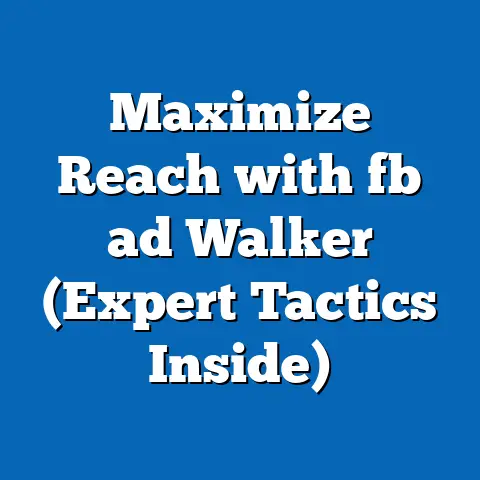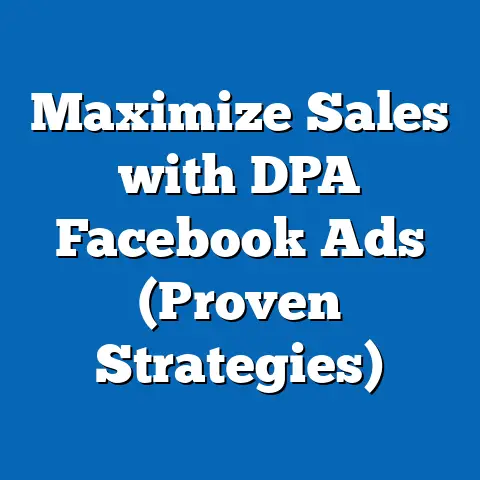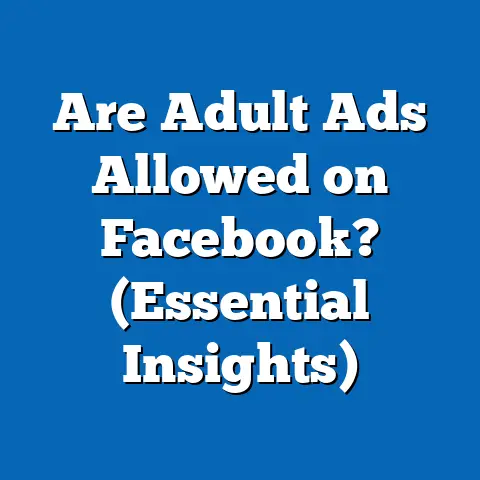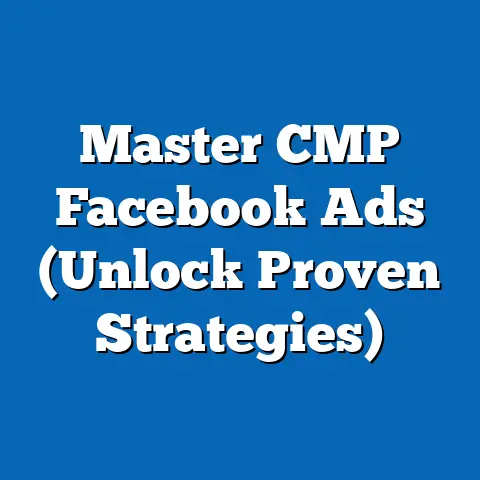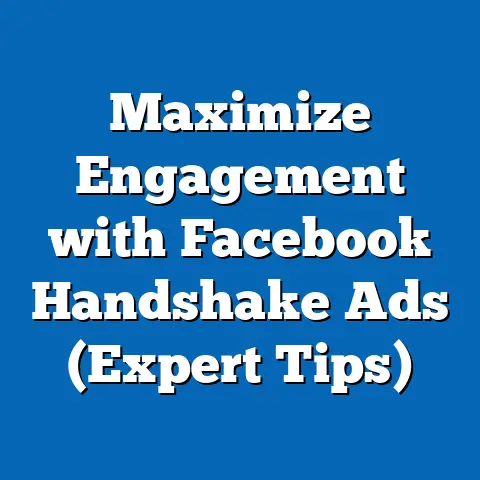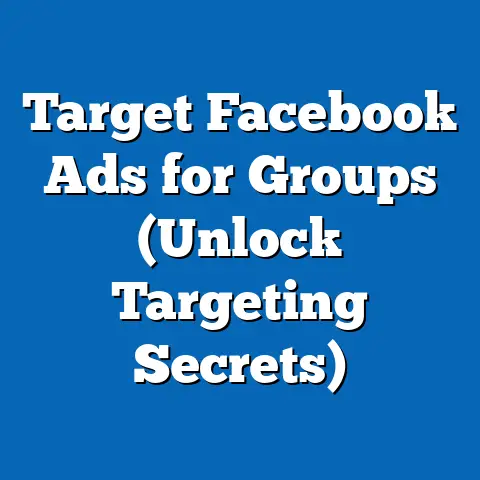Maximize Facebook Ads Audience (Proven Strategies)
Facebook advertising remains one of the most powerful tools for businesses aiming to reach a vast and diverse audience. With over 2.9 billion monthly active users as of Q2 2023 (Statista, 2023), the platform offers unparalleled access to potential customers across demographics and geographies. However, the challenge lies in maximizing audience reach while maintaining cost-effectiveness—a critical concern for marketers working with limited budgets.
This comprehensive article explores proven strategies to optimize your Facebook Ads audience for better results. We begin by focusing on cost-effectiveness, supported by key statistics and trends, and then delve into actionable tactics to refine targeting, enhance engagement, and drive conversions. By leveraging data-driven insights and historical comparisons, this guide aims to equip businesses of all sizes with the tools to succeed on the platform.
The Importance of Cost-Effectiveness in Facebook Advertising
Cost-effectiveness is the cornerstone of any successful digital advertising campaign, particularly on a platform like Facebook where competition for ad space is fierce. According to a 2023 report by Hootsuite, the average cost-per-click (CPC) for Facebook Ads across industries is $1.72, though this varies widely by sector—retail averages $0.70, while legal services can climb to $1.32 per click. Meanwhile, the average cost-per-thousand-impressions (CPM) stands at $7.19, reflecting the need for precise targeting to avoid wasted spend.
These costs have risen over the years due to increased competition and changes in ad algorithms. For comparison, in 2019, the average CPC was $1.01, representing a 70% increase in just four years (WordStream, 2023). This upward trend underscores the urgency for advertisers to adopt strategies that maximize audience reach without inflating budgets.
Demographically, Facebook’s user base is diverse, offering opportunities to tailor campaigns for specific groups. As of 2023, 56.8% of users are male, and 43.2% are female, with the largest age group being 25-34 years old, accounting for 29.9% of the user base (DataReportal, 2023). Regionally, Asia-Pacific dominates with 1.2 billion users, followed by Europe and North America. Understanding these demographics is crucial for cost-effective targeting, as ad costs can vary significantly by location and audience segment.
Historical Trends vs. Current Landscape
Looking back, Facebook Ads were once a relatively low-cost option for businesses. In 2015, the average CPM was just $5.31, compared to $7.19 in 2023—a 35% increase (AdEspresso, 2023). This rise correlates with the platform’s growing user base and advertisers’ increasing reliance on digital channels, especially post-pandemic.
Another shift is the impact of privacy regulations and platform updates. Apple’s iOS 14 update in 2021, which introduced App Tracking Transparency (ATT), limited Facebook’s ability to track user behavior across apps, leading to a reported $10 billion revenue loss for Meta in 2022 (CNBC, 2022). For advertisers, this meant reduced targeting precision and higher costs to achieve similar results. However, Meta has since adapted by enhancing on-platform analytics and machine learning tools to improve ad delivery.
Today, advertisers must navigate a landscape where data privacy concerns coexist with advanced targeting capabilities. The focus has shifted toward first-party data and creative optimization to maintain cost-effectiveness. Businesses that adapt to these changes are better positioned to maximize their audience reach without overspending.
Demographic Patterns and Targeting Opportunities
Demographic targeting is a key lever for cost-effective Facebook advertising. Data from Statista (2023) shows significant variations in user engagement by age and gender. For instance, users aged 18-24 are more likely to engage with visually dynamic ads, with a click-through rate (CTR) of 1.2%, compared to 0.8% for users aged 45-54.
Geographic targeting also plays a critical role. Advertisers in North America face higher CPMs—averaging $12.50—compared to emerging markets like India, where CPMs can be as low as $0.50 (Hootsuite, 2023). This discrepancy offers opportunities for businesses to test campaigns in lower-cost regions before scaling to more competitive markets.
Additionally, interests and behaviors provide deeper targeting layers. For example, users interested in fitness are 30% more likely to click on health-related ads, while parents aged 25-34 show higher engagement with family-oriented products (Facebook Business Insights, 2023). Leveraging these insights allows advertisers to allocate budgets more efficiently, focusing on high-value audience segments.
Proven Strategies to Maximize Facebook Ads Audience
Having established the importance of cost-effectiveness and demographic targeting, let’s explore actionable strategies to maximize your Facebook Ads audience. These tactics are grounded in data and best practices, ensuring both reach and return on investment (ROI).
1. Leverage Lookalike Audiences for Precision Targeting
Lookalike Audiences are one of Facebook’s most powerful tools for expanding reach while maintaining relevance. By using existing customer data or high-performing audience segments, advertisers can target users with similar characteristics. According to Meta, campaigns using Lookalike Audiences achieve a 20-30% lower cost-per-acquisition (CPA) compared to broad targeting (Meta for Business, 2023).
How to Implement: Upload a customer list or use website visitor data to create a source audience. Then, build a Lookalike Audience with a 1-2% similarity range for higher precision. Test different audience sizes to balance reach and cost—smaller percentages often yield better results but may limit scale.
Data Visualization Description: Imagine a bar chart comparing CPA across three audience types: broad targeting ($15 CPA), interest-based targeting ($12 CPA), and Lookalike Audiences ($9 CPA). This visual highlights the cost savings potential of Lookalike Audiences.
2. Optimize Ad Creative for Engagement
Creative elements—images, videos, and copy—directly impact ad performance and cost-effectiveness. A 2022 study by AdEspresso found that video ads have a 12% higher CTR than static image ads, while carousel ads outperform single-image formats by 10-15% in terms of engagement.
How to Implement: Use high-quality visuals with clear calls-to-action (CTAs). Test multiple ad formats to identify what resonates with your audience. For instance, a short, 15-second video showcasing a product in action can drive higher engagement among younger demographics (18-24), as they spend 60% more time watching video content on social platforms (Nielsen, 2022).
Additionally, refresh creatives regularly to combat ad fatigue. Meta reports that ad performance drops by 30% after two weeks of continuous exposure to the same creative (Meta Insights, 2023). Rotate visuals and messaging to maintain audience interest without increasing spend.
3. Utilize Detailed Targeting Options
Facebook’s detailed targeting options allow advertisers to hone in on specific interests, behaviors, and demographics. Campaigns using layered targeting (e.g., combining interests with behaviors) see a 25% improvement in CTR compared to single-layer targeting (WordStream, 2023).
How to Implement: Start with broad categories like “fitness enthusiasts” and narrow down using behaviors such as “recently purchased gym equipment.” Exclude irrelevant segments to reduce wasted impressions—for example, exclude existing customers from acquisition campaigns to lower costs.
Demographic Focus: Tailor messaging for high-engagement groups. For instance, women aged 25-34 respond 18% more frequently to lifestyle and beauty ads, while men in the same age group show higher interest in tech and gaming content (DataReportal, 2023).
4. Implement Retargeting Campaigns
Retargeting is a cost-effective way to re-engage users who have already interacted with your brand. According to a 2023 report by Criteo, retargeted ads have a 70% higher conversion rate compared to ads targeting new users. Additionally, the average CPA for retargeting campaigns is 40% lower than for prospecting campaigns.
How to Implement: Use the Facebook Pixel to track website visitors, app users, or video viewers. Create custom audiences based on specific actions, such as “added to cart but didn’t purchase,” and serve tailored ads with incentives like discounts. Limit ad frequency to 3-5 impressions per user to avoid annoyance, as overexposure can increase CPA by 20% (AdEspresso, 2023).
5. Test and Optimize with A/B Testing
A/B testing is essential for identifying cost-effective strategies. By testing variables like ad copy, visuals, and audience segments, advertisers can optimize campaigns in real time. A 2022 study by Hootsuite found that campaigns using A/B testing saw a 15% reduction in CPC and a 20% increase in CTR.
How to Implement: Run split tests with small budgets to compare two versions of an ad. For example, test a static image against a video ad for the same audience segment over a 7-day period. Use Facebook’s Campaign Budget Optimization (CBO) to automatically allocate spend to the best-performing variant.
Data Visualization Description: Picture a line graph showing CPC trends over 30 days for two ad sets: one with A/B testing (decreasing from $2.00 to $1.50) and one without (steady at $2.00). This illustrates the cost-saving impact of iterative optimization.
6. Focus on Mobile-First Design
With 98.5% of Facebook users accessing the platform via mobile devices (Statista, 2023), mobile optimization is non-negotiable. Ads designed for mobile screens achieve a 27% higher CTR compared to desktop-focused creatives (Meta for Business, 2023).
How to Implement: Use vertical or square formats (e.g., 9:16 or 1:1 aspect ratios) for better visibility in mobile feeds. Ensure text overlays are minimal, as Facebook limits ads with more than 20% text in images. Test load times—ads loading in under 3 seconds see a 15% higher completion rate for video content (Google, 2022).
7. Monitor Frequency and Ad Fatigue
High ad frequency can lead to audience fatigue, increasing costs and reducing effectiveness. Meta data indicates that an ad frequency above 5 impressions per user results in a 10% drop in CTR and a 15% increase in CPC (Meta Insights, 2023).
How to Implement: Use Facebook Ads Manager to monitor frequency metrics weekly. If frequency exceeds 3-4, refresh creatives or pause the campaign temporarily. Expand audience pools using Lookalike Audiences to distribute impressions more evenly.
Broader Implications and Future Trends
Maximizing your Facebook Ads audience while maintaining cost-effectiveness requires a blend of precise targeting, creative optimization, and continuous testing. As competition on the platform grows—evidenced by the 35% rise in CPM since 2015—advertisers must stay agile, adapting to privacy changes and evolving user behaviors. The strategies outlined above, from Lookalike Audiences to mobile-first design, provide a roadmap for achieving better ROI without breaking the bank.
Looking ahead, trends like artificial intelligence (AI) and automation will shape the future of Facebook advertising. Meta’s Advantage+ tools, which automate ad placement and targeting, have already shown a 20% improvement in campaign efficiency for early adopters (Meta for Business, 2023). Additionally, as younger demographics shift toward platforms like TikTok, Facebook’s focus on retaining older users (35+) may influence targeting costs and strategies.
Another consideration is the growing importance of video content. With video ads driving higher engagement, businesses that invest in short-form, authentic content will likely see sustained cost benefits. For instance, user-generated content (UGC) in ads has a 28% higher trust factor among viewers, translating to lower CPAs (Nielsen, 2023).
Finally, global economic conditions will impact ad spend. In 2023, 45% of small businesses reported reducing digital ad budgets due to inflation (Forbes, 2023). This highlights the need for cost-effective strategies that prioritize high-impact audience segments over broad, expensive campaigns.
Conclusion
Facebook Ads remain a vital channel for reaching diverse audiences, but success hinges on cost-effective execution. By leveraging tools like Lookalike Audiences, optimizing creatives, and focusing on data-driven testing, advertisers can maximize reach without overspending. Historical trends show rising costs—CPM up 35% since 2015—yet strategic targeting and mobile optimization offer pathways to efficiency.
Demographic insights, such as the high engagement of 18-24-year-olds with video content or regional cost disparities, further refine these efforts. As the platform evolves with AI and privacy-focused updates, staying ahead of trends will be critical. Ultimately, the ability to adapt and innovate will determine whether businesses can turn Facebook’s vast audience into measurable results.

